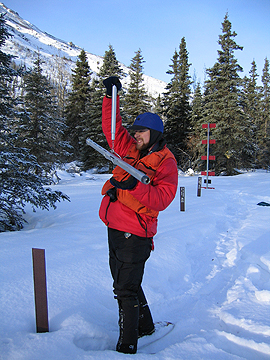The muted colors of the winter sunrise paint the sky in oranges and purples. It’s 10:35 a.m., and the thermometer outside the window reads 35 degrees below zero. This valley bottom might be cold, but if you climb the hill, the temperature could be 10 to 15 degrees warmer. Because cold air sinks, winter temperature inversions are common. The temperature can hover below zero for days or sometimes weeks, but in time we will get a south wind — a Chinook — that will bring warm moist air from the Gulf of Alaska.
When these
winds begin to blow, temperatures can rise as much as 70 degrees in a
matter of hours.
The coldest months of winter are December and January. Not coincidentally, this is when we have the least amount of daylight. On Dec. 21, the first day of winter, the sun will rise at 10:46 a.m. and set at 3:03 p.m., giving us only four hours and 17 minutes of possible daylight. The azimuth of the sun at this time of year is very low due to the Earth’s tilt away from the sun. It will not rise above eye level all day. If you happen to live where there are mountains to the south, the sun may be hidden from you for a month or two.
The snow crunches as the bond between snow crystals breaks with every step. Icicles form on your eyelashes. You pull your hat on tighter — you’re warm because you dressed for the cold. Animals that are year-round residents of the park have adapted to this environment as well. Larger animals exposed to conditions above snow must adapt their behavior, feeding habits and morphology accordingly. Snowshoe hares and ptarmigan change from brown to white to blend in with the snowy environment, which offers better protection from predators. One interesting phenomenon of the subarctic is the survival of the wood frog, the only amphibian that lives at these high latitudes. The wood frog winters below the snow as a living ice cube. It keeps its cells unfrozen by moving water out and glucose in, allowing the water to freeze in the spaces between the cells.
If you are a
small animal or plant, one of the key factors helping you to survive is snow.
In the subnivean world, meaning beneath the snow, organisms and soil rely on
the insulating capacity of snow for heat retention. The snow cover maintains
ground temperatures that can be as much as 30 degrees higher than
air temperatures found above the snow. It also covers and protects low-lying
plants, reducing drying from winter winds, and provides a world of tunnels for
tiny rodents safe from the searching eyes (though not always the sharp ears) of
predators. This seasonal snow cover, lasting up to eight months, is an
important ecological factor for this ecosystem. Because of the important role
of snow in the ecosystem, Denali scientists
conduct monthly snow surveys from November through May to record the patterns
of snow cover across the park. Looking up from the snow at your feet to Denali’s winter sky on a cold, clear night, you may be
lucky enough to witness the spectacular color displays of the aurora borealis,
also known as northern lights. The amazing colors and formations are produced
by the solar wind, a stream of electrons and protons coming from the sun, as it
collides with oxygen and nitrogen atoms in the upper atmosphere. Pale green or
white are the most common colors, but you may be lucky enough to witness pinks
and deep purple-reds as well. And be on the lookout during daylight hours for
another interesting phenomenon, sun halos. These colorful rings occur around
the sun when light is refracted as it passes through ice crystals. There are
many types of halos. One of special note is the parhelion or “sun dog.” Sun
dogs are luminous spots on both sides of the sun that occasionally occur with a
halo.
After a few
hours out in the winter weather, either trekking through the snow in the low
winter sunlight or skiing along a darkened trail under the soft glow of
northern lights, it’s time for one of our human adaptations to this environment
— a warm beverage in front of a fire in a cheerfully lighted cabin. Just outside,
the quiet drama of survival in a northern environment carries on as it has for
millennia. And tomorrow is another day full of winter wonders.
Pam Sousanes has been working in Denali National Park year-round since 1998. As an environmental specialist, she maintains 18 remote weather stations and manages the climate- monitoring program for the Central Alaska inventory and Monitoring Network, which includes more than 21 million acres.



 Print Version
Print Version
 E-mail This Article
E-mail This Article
